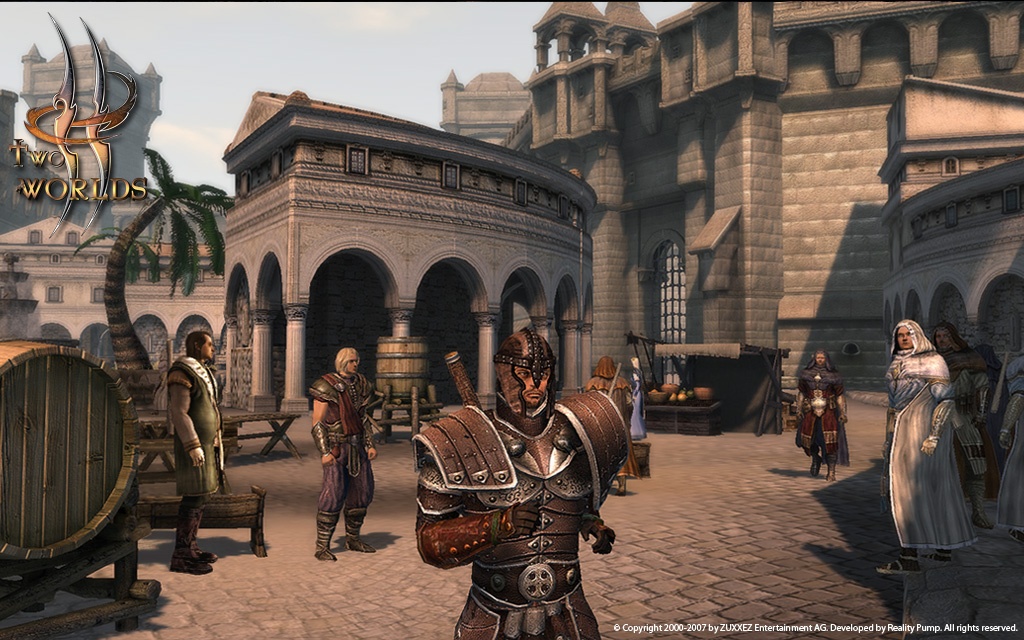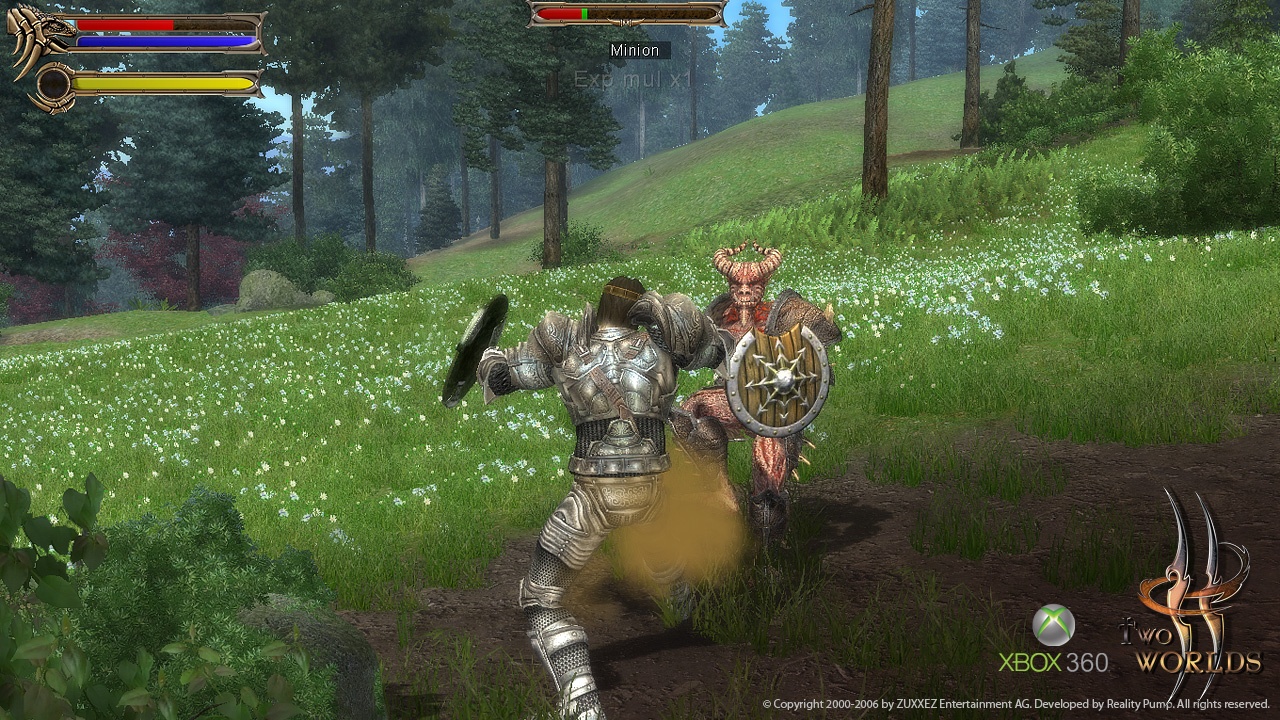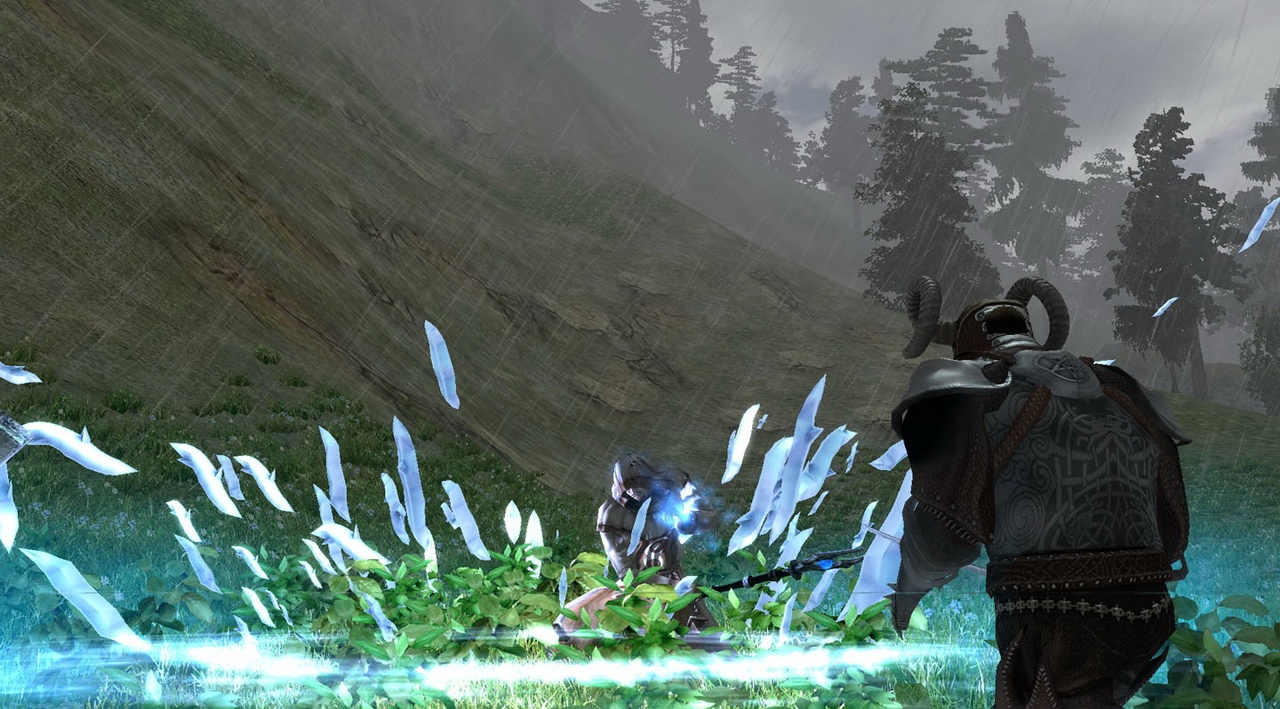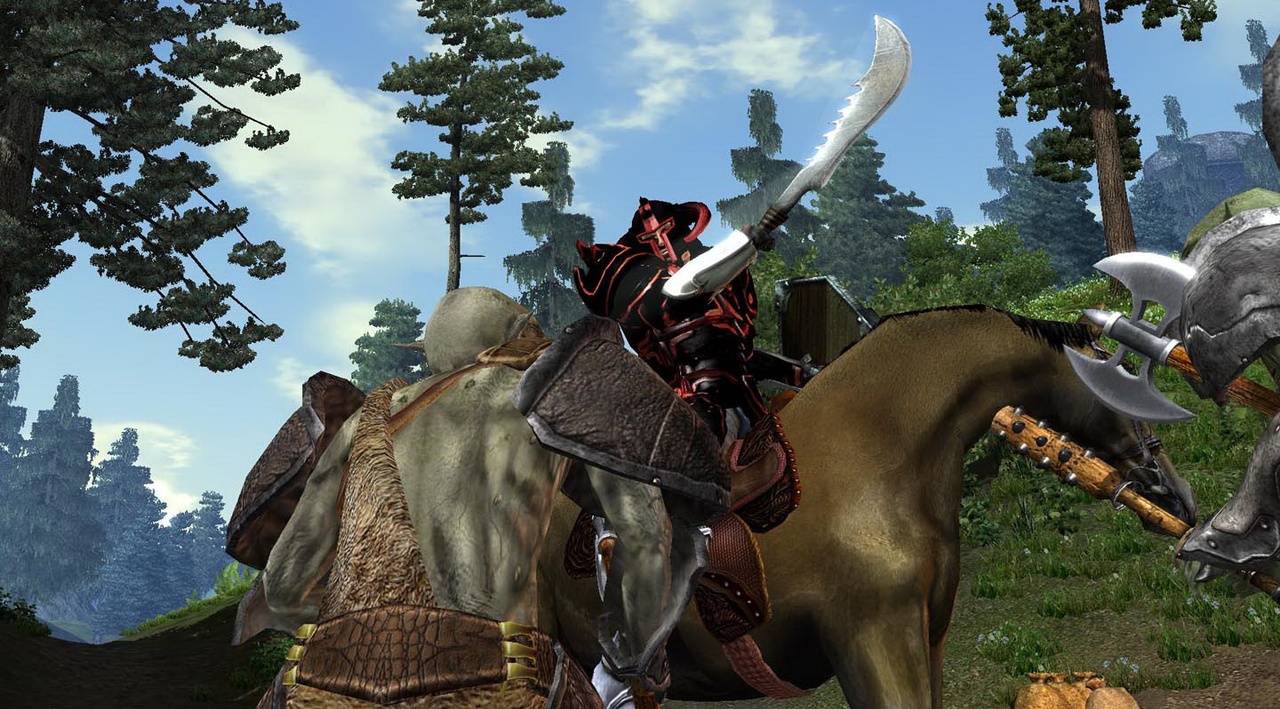A poor man's Oblivion. This description may seem a bit damning, but it puts the game in awfully fine company when you consider the sheer greatness of Bethesda's role-playing game opus. Reality Pump's RPG certainly has it where it counts in the aspiration department, even if, largely due to some design quirks, the first-time RPG developer can't quite match the gold standard established by Oblivion last year. With that said, the epic scale of the game, along with outstanding character development, free-flowing action, and good quest variety, make it a worthwhile play for any RPG aficionado.
In an exact reversal of the problems that Oblivion players on the PC griped about in 2006, Two Worlds' biggest issue on the Xbox 360 is its PC-centric design. This is actually a welcome surprise in some ways, as PC RPGs typically boast more depth than their console counterparts when it comes to storyline, character creation, and sheer scope of the gameworld (and that is certainly the case here). However, this focus is a big problem in other respects.

For example, everything about the interface is geared for a close-up monitor. Even on a large HDTV, it's nearly impossible either to read the minimap on the main adventure screen or to determine at a glance what the icons are on the big map when you pull it up to full size. This can be a serious problem, as the gameworld is so huge and the number of points of interest so tremendous that it's easy to get lost or backtrack for miles without realizing that you got turned around somehow. Text is so minuscule that it might as well be the fine print on a mortgage. Furthermore, the inventory is a clunky affair in which you have to scroll across all of your items every time you want to use a potion or swap out a weapon. You can pretty readily tell that the whole thing was designed with a mouse, keyboard, and monitor in mind, not a gamepad and TV. Regardless, you do grow to tolerate these drawbacks after an hour or two of squinting. The game beyond the interface is worth the eyestrain, and if you happen to be playing on the PC, you won't run into any such issues.
The story is stock-standard for this sort of RPG. The backdrop deals with a war in the land of Antaloor between man and orc that resulted in the imprisonment of the orcish god Aziraal in a magical tomb. When the game opens, 300 years have passed and a dwarven mining expedition has possibly uncovered the big guy's final resting place, which doesn't bode well for relations between humans and orcs. You're a mercenary just trying to get by, one who is more concerned with rescuing his missing sister than saving the world or even looking into what's got the orcs all riled up as of late. As with most open world RPGs, you can dive straight into this main storyline and take on all of its quests, or freely wander the world while helping people and killing monsters for fun and profit. It's important to note that there is no level-balancing or similar gimmicks present here, which means that you need to finish a fair number of side quests to gain the experience and equipment needed to send Aziraal and his orc pals packing.
So the plot isn't going to set the world on fire, although the personal angle with your sister and the overall character design and development are somewhat innovative. There are no classes here, so after creating your male protagonist (there is no option to roll up a member of the fairer sex) and customizing little things like hair color and arm length, you're left to place the attribute and skill points awarded with level increases wherever you want. If you want a fighter, for example, you have to buff strength and vitality stats, and increase scrapping skills like damage and critical-hit chance. For a mage, you go with willpower and magical skills such as necromancy and the four elements. Or you could try a jack-of-all-trades and distribute points all over the place so you can whip out a sword or a spell depending on the circumstances.

There are no restrictions when it comes to the use of weapons, magical items, spells, and the like, at least in comparison with the more closed D&D-style systems. Nevertheless, most hardware does have attribute requirements that limit the really good weapons to fighter types, the really good magical staffs to mage types, and so on. On the other hand, all characters can use the alchemy pot that forms half of the inventory screen. Items like crystals and plants can be gathered throughout the game and brewed into health potions and various other elixirs that can buff your stats, or even add poison or flame damage to weapons. Overall, this is a nice extra touch that opens up the game and lets even a hardcore fighter play mage every now and then.
Fewer options are available when it comes to developing your character in the game itself, because NPC interactions are pretty blah. While it's refreshing that you're an out-for-himself mercenary instead of the usual RPG saint or dog-kicking villain, there are few choices in conversations. You always hit up passersby with the same bland questions depending on your location, and you always get the same canned responses. When being asked to undertake a quest, your choices generally include only "Yes, how much?" and "No thanks, not interested." At least the NPCs are designated with colored icons, which means that all you have to do is look for green to know if they have anything of value to say before you even start flapping your gums. Conversations also get right to the point, and can be skipped through quickly if you've heard it all before. All lines are delivered by voice actors, which adds some life to the chatter. Quality is all over the place, ranging from cheesy to dull monotone. You're guaranteed to get some chuckles out of the action-hero quips of the lead. Lines like "Say hello to death!" and sarcastic comments about the weather when it rains don't seem entertaining on paper, but the bombastic delivery is so hilarious that they work in spite of themselves.
Combat in Two Worlds is similarly straightforward. The third-person camera (you can switch to first-person on the PC, but only when you don't have any weapons equipped) allows for quick, button-mashing action that doesn't require a great deal of thought. Melee fighters can take advantage of combo attacks, although battles generally require nothing more than hammering on the left trigger as quickly as possible until the bad guys fall down. The magic system is just as basic, with a default attack that functions similarly to the melee option, and spells that can be quickly cast with cards. But even though battles are simplistic, they're far from easy. The only way to succeed when fighting on the medium or hard difficulty settings is to do a lot of dodging and running away, and to time your assaults to land in-between enemy swipes. Of course, considering that the game features a lot of combat, this sort of futzing around gets annoying fast. It's a lot more sensible to turn the difficulty setting to easy (which is still very challenging) and not deal with this dart-and-dodge fighting. Even then, you'll still get killed quite a bit. However, this isn't a hassle, given that you respawn immediately at one of the many healing shrines scattered throughout Antaloor.
The monsters that you'll slay aren't quite varied enough for an RPG of this length and scope. While scraps fly past so quickly that boredom will rarely be an issue, it seems like you're killing the same packs of wolves, bears, and boars in the wilderness over and over again. And that does get dull, because after the first hour or so of play, you've got enough experience and weaponry to slaughter these beasts in mere moments. Other creatures include fantasy RPG stereotypes like the goblinesque groms, as well as orcs, dwarves, skeletons, ghouls, and dragons, along with more esoteric selections such as Flintstones-refugee reapers, man-sized jackals, and giant bugs known as trachidis. There seems to be a good number of monsters spread through the entire game; it's just that the repetition of specific types in certain areas makes you feel like you're on a treadmill at times. Reality Pump just hasn't filled Antaloor with a menagerie quite befitting its tremendous size.
Quests provide more variety. There are dozens upon dozens of assignments available, spread all over the world. They range from standard delivery jobs to solving murders, from stealing underwear to collecting herbs, and, of course, slaughtering tribes of groms and orcs. Most of the quests are also set within a realistic backdrop of factions and interests. Groups in the game, including the knightly Brotherhood as well as the guilds representing such disparate folk as merchants and necromancers, hire you for jobs at various points. A consequence is that your reputation increases amongst different crowds of NPCs. The world itself is tied together with realistic geographical features and common teleportation platforms that let you take shortcuts after an initial reconnaissance of the map. So you can take in some postcard vistas when you want to sightsee, and when you want to just zip around, you can minimize aimless wandering with this magical transit system (or by hopping on a horse, although the nags in the game are so tough to control that it's easiest to just stay on foot).

Multiplayer gives Two Worlds a little something extra not offered by most other RPGs. On the PC, Reality Pump has given the game a basic arena-combat venue where you can go online and duke it out with human opponents, but the real meat is in the quasi-MMO mode of play in which you can wander Antaloor and take on quests with online pals. About the only major differences between this option and the solo campaign is the lack of the story here and the ability to pick specific character classes from lists of warriors, rogues, and mages instead of custom-crafting a hero with stat and skill choices. This isn't quite the cooperative play-through of a full campaign that RPGers have been dying for, but it's certainly an innovative idea. The only problem is difficulty. Even the introductory quests are extremely hard, which pretty much forces you to group up with other players to have a chance at survival. Co-op play is also an iffy proposition because there seem to be only a couple dozen players online at any given moment right now. If the game gets more popular, this mode of play could really take off.
At any rate, this multiplayer mode is miles above the dreary (and laggy) limited online option available with the Xbox 360 version of the game. Instead of the cooperative campaign play that RPGers have been dreaming of, all the developer has included here are dull host-or-join game modes like deathmatch (deeply bland because of the simplistic combat system), monster hunt (better due to the addition of an objective, but still too repetitive to enjoy for long), and an RPG option where you develop a character courtesy of hacking and slashing through quests on one-off maps with up to seven buddies. The latter pales in comparison to the multiplayer offering featured in the PC edition of the game, as it features full server support that makes maps feel more like persistent worlds, along with player numbers that roughly resemble what's available in MMOs. Anyhow, the only distinction with the MP games here is a wide variety of set character classes, including specialty warriors such as the blade dancer, as well as mages focusing on the elements and necromancy. Even if you want to try these half-baked games, they're often unplayable due to frequent dropped connections and serious lag that regularly turns combat into a slide show. Very few people seem to be taking advantage of the online play at this point, which isn't exactly a surprise when you consider its quality. Ultimately, if you want online RPG action, look toward the PC version.

Visual and audio quality aren't quite fully realized. The game's artwork looks great due to gorgeous mountain ranges, grassy hills, detailed monster and character textures, and nicely varied city and village architecture, but frame-rate hitches and loading pauses frequently interrupt the action on the 360 version. Quick pauses during combat happen in virtually every scrap with more than a couple of opponents. This doesn't affect the overall playability of battles, but remains awfully annoying nevertheless. Section loads are also frequent, if brief. A little disc icon pops onto the screen every so often while you're wandering through the woods, during which the game pauses for a few seconds. This can be a little irritating, although it's certainly preferable to long loading times. However, sometimes the game pauses without flashing the disc icon, which means that the game has either additional, unadvertised loads or a few bugs. The PC version doesn't have any of these hitching issues. Much of the experience is seamless, with area loads being barely noticeable. Best of all, everything runs smoothly on even a mid-grade, single-core machine with a 6800-class video card. You need to dial the graphics back to 1024x768 to avoid choppy combat, although this is a small price to pay to get a game this big and attractive to run so well.
Audio quality is mixed. As previously noted, the dialogue is an amusing blend of cheese and action-hero clichés. Atmospheric battle effects are generally excellent, if not pronounced enough to make you aware of their presence. The same goes for most of the soundtrack, which is noteworthy only for some ethereal odes à la Enya and the fact that it was composed by '80s one-hit wonder Harold "Axel F" Faltermeyer. The only real standout tune is the ominous bass-heavy piece that eerily wells up whenever your hit points plummet to near-death levels.
If you appreciate ambitious RPGs, seek out Two Worlds. It won't make you forget about Oblivion, but Reality Pump's take on heroic fantasy adventure is good enough to consume many, many hours of your spare time. Even though there are some flaws here, especially with the 360 version of the game, this is a solid role-playing experience.